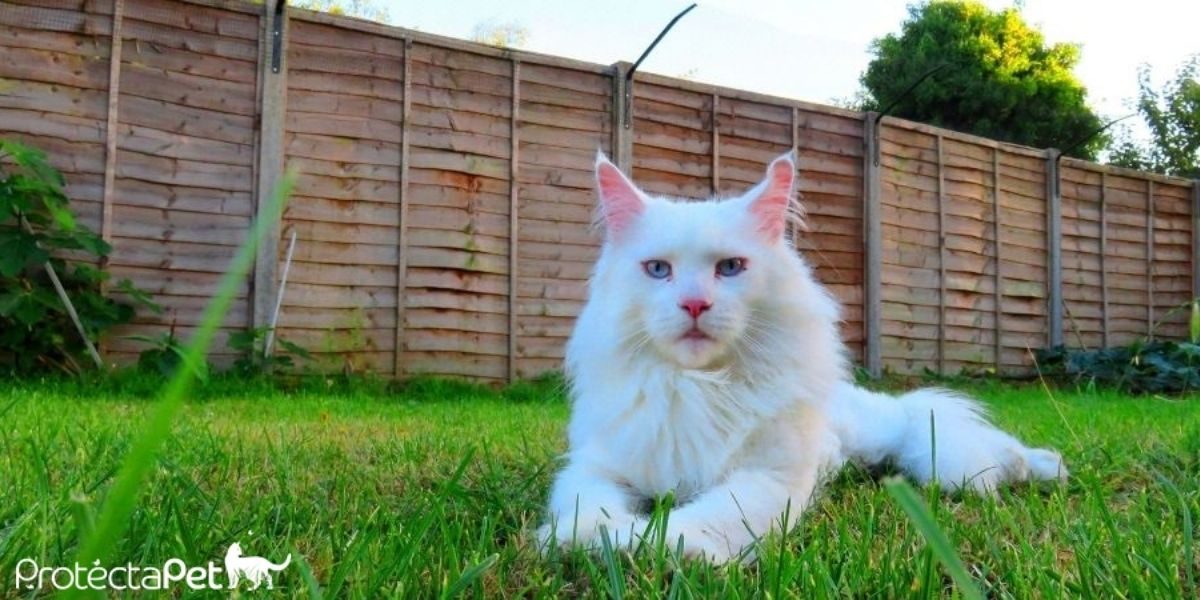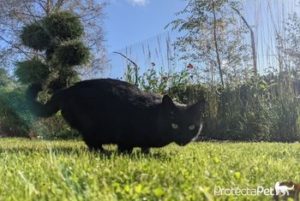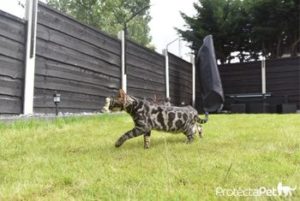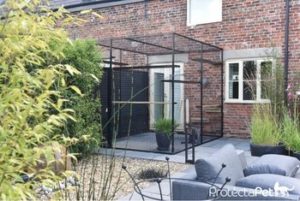For many people, a major deterrent to having a cat as a pet is the problem of keeping it safe and well without restricting it from leading a normal, happy, outdoor life. However, the problem of keeping an active cat in a safe environment can be solved without necessarily condemning the cat to a life indoors.
Cats which have been kept indoors all their lives adapt reasonably well to their environment provided that they are given ample companionship and attention. However, such an enclosed environment is far from ideal and a solution which permits the cat to have access to a garden, as well as the house, is preferable.
The advantages of providing an enclosed environment for domestic cats are many. Safety is high on the list but there is also relief from the fear of them being run over, of them causing a problem by digging up the neighbour’s best plants, or of them being injured by predators. The need to provide a protected environment becomes more important as the number of hazards rises.
How you can provide controlled outdoor access for your cat depends on how much, and what kind of, outside space you have, but there are options available regardless of whether you have a patio, balcony or large garden, and there are a number of companies that produce and install spaces to fit almost any specification. We’ve provided a list of those we recommend below, and if they’re not available in your country, you can also use their products to give you an idea of how you might be able to create and build something yourself.
- www.protectapet.com
Friend and partner of iCatCare, ProtectaPet will donate 10% of your order value to iCatCare - www.colourfence.co.uk
- www.katzecure.com
- www.purrfectfence.co.uk
- www.secur-a-cat.com
- www.felisafe.co.uk
In the body of the article we’ll be looking in more detail at the types of enclosure, some common considerations and we even have a handy guide for how you can construct your own space!
Fence or enclosure?
There are two possibilities available to the cat owner. The first of these is to fence the garden, either completely or in part, to prevent the cats from getting out. Such fencing can, with a neighbour’s consent, be adapted to prevent outside cats getting in – a solution which may be attractive to owners of gardens full of plants constantly being uprooted by neighbourhood cats. There can, however, be a problem if there are any perimeter trees which overhang such a fence. The presence of such trees will enable the cats to climb on top of the fence and escape into the outside world. Judicious pruning may help, but the problem remains that an active cat can both climb and leap from branch to fence and so escape.
Fencing the trees themselves is a possibility by ‘bonnetting’ or giving the tree an Elizabethan collar. Trees which pose a problem can be trimmed up to a height of 1.8m (6ft) and made secure by attaching wire mesh, horizontally, under the lowest remaining branches to prevent cats climbing upwards into the trees. Loosely attach a loop of wire around the trunk immediately below the main branches. Attach another loop about 1 metre (3ft 3in) out to the same branches. Stretch the wire mesh between these loops, attaching it at regular intervals to the supporting branches. Where such trees adjoin a fence, the ‘bonnet’ can be attached to the wiring of the fence, effectively boxing the cats in. Leaves and small branches growing down through the wire soon make such fencing virtually invisible.
However, it must be stressed that, if you live in a designated conservation area or any trees in your garden are subject to a preservation order, you must consult the planning department of your local Council before trimming or pruning any trees.
Gardens vary in size and shape and what may be practical for one will not necessarily work in another. Nevertheless, it should be possible to create a safe haven in at least one part of a garden. Problems with neighbours’ fences, uneven ground, or overhanging branches will inevitably arise and allowance must be made for these when adapting the following suggestions.
The cat-proof garden
To make a garden cat-proof will require the creation of a border fence of at least 1.8m (6ft) in height which, in the case of a wooden structure, means uprights of at least 2.3m (7ft 6in) so that there is sufficient length to fix in the ground. These uprights should be at least 8 x 5cms (3in x 2in) and should be placed not more than 1.8m (6ft) apart. It is advisable to ensure all timber below ground level is properly treated with a preservative and that the posts are set in concrete to provide a more rigid structure. An existing brick or stone wall may be used and can be extended to the requisite height with a wooden framework to form the basis for the wiring. The use of trellis sections can improve the appearance of safety fencing and will permit lightweight trailing plants to be trained along it.
It is always wise to discuss plans for a new fence or garden wall with neighbours to ensure that no objections will occur, particularly if there is no existing boundary fence. It is also very important to discuss the construction of fences over 2m high (6ft 6in) with the local authority planning department as planning permission may be required. Permission will definitely be required for any fence or enclosure above 1m (3ft 3in) along a road frontage. In some housing developments, there may be legal covenants and/or local restrictions which prevent fencing being erected on either front or side gardens. Whatever the situation, it is always advisable to check with your solicitor, neighbours and the local authority’s planning officers before incurring the expense of building the new fence.
How it’s done
The actual escape-prevention system needs to be constructed at the top of this 2m (6ft 6in) wall or fence. There are various methods of doing this, using either a fixed framework or brackets and stretcher wires. Likewise, the actual fencing may be rigid or flexible, according to the type of wiring or netting used. A rigid wiring may well outlast the softer fruit netting but is easier for the cat to climb. In either case, the basic approach is the same.
Once the fence or wall has been raised to the necessary height, a horizontal section should be constructed, jutting out at right angles into the garden for at least 0.5m (18in – 2ft), thus creating an overhang. Alternatively, this section may be built at an upward angle of 45 degrees. This has a slight advantage in that the cat is less likely to jump on to it from above if there are trees nearby but, since it is easier for a cat to climb, it may require a longer vertical drop down. This drop-down should be attached to the garden edge of the horizontal or angled section, to hang parallel to the original wall or fence. It should hang down approximately 0.30m (12in).
Both these sections, the horizontal or angled section and the drop down, may be built of a rigid framework. Alternatively, metal angle brackets can be attached to the wall or fence and stretcher wires run between them to support whatever wire mesh or netting is used.
The framework or brackets should be covered with either welded wire mesh or chicken wire, which should be firmly stapled to the wooden framework or tied to the metal brackets. Wire mesh should be of 16 gauge (1.6mm) and the mesh size not more than 2.5cm (1in). Chicken wire is cheaper than wire mesh but may not last so long. It should also be of 2.5cm (1in) mesh. The use of a larger mesh may permit a small cat or a kitten to push its head through the mesh and get trapped. The same applies to chain link fencing which has sufficient ‘give’ in the mesh to trap a cat by the head.
All wire fencing or netting should be carefully erected and the joins between sections made secure. This can be done by weaving a lightweight stretcher wire through the mesh or by tying the mesh to the stretcher wire at regular intervals of not more than 25cms (10in), preferably less.
A rigid fence is easily climbed by most cats, so too are wooden uprights, no matter which side the wiring is attached. One attraction of the 16 gauge wire mesh is that it does provide a strong climbing frame and play area for active cats. However, an agile cat which can occasionally cope with the first horizontal overhang cannot normally cope with the second drop down section. It is obliged, therefore, to stay in its own garden. Where the bottom of the wire is not attached to a solid structure (timber framing or a stone or brick wall), or where the ground level is uneven, the wire should be buried to a depth of at least 10cms (4in) since persistent cats can bend the wire sufficiently to crawl out underneath it. Equally important, other animals can attack the wire from outside the garden and gain access to the cat run, so preferably bury the wire as deep as is practically possible.
Should this type of fencing be developed into a T-shape or a Y-shape rather than simply the upside down L, it will also serve to prevent outside cats from entering the garden. However, any branches which overhang the fence or any tree growing within 2.5m (8ft) of it will permit an agile cat to jump on top of the fence and so cross to the other side – in either direction. In other words, a neighbouring tree may allow an unwanted cat to have access. It will then find it cannot escape! To angle the horizontal section upwards at 45 degrees generally prevents such acrobatic behaviour as cats are more loath to jump on to a slanting surface.
Any gates giving access to the garden will have to be given similar treatment. If the gate is tall enough, the fence can run continuously across the top of it – but not, of course, attached to it. Any gap below the gate must also be dealt with. For example, the ground level may be raised by laying paving stones or the bottom of the gate extended by the addition of an extra crossbar and wiring to reduce the gap to an absolute minimum. If the gate opens on to a road, planning permission may have to be sought before any additional fencing is erected. If, however, it stands at the side of a house between neighbouring properties, then an extension to a height of 2m (6ft 6in) may be permitted. Again, it is always wise to check with the planning department before undertaking such work. Of course, any gate must inevitably be opened at some time and offers a splendid opportunity to the cunning and adventurous cat. A ‘please shut the gate’ notice may help here.
Purpose built enclosure
Enclosing the entire garden will present no problem of access to the house for cats but may be impossible to achieve because of the size or the nature of the garden. The alternative solution is to create a purpose-built enclosure specifically for the cats. Here, provision must be made for the animals to be protected from the weather throughout the year, either by having access to the house through a cat flap or window or by the provision of a purpose built cat house or chalet.
This purpose built enclosure can be constructed to provide a special cat run within, or as part of, the garden. It may be open, in the sense that its ‘walls’ are constructed with the same type of fence and overhang as described previously for the whole garden, or it may be totally enclosed with a roof, this roof being made either of wire mesh, like a fruit cage, or of PVC. If the need is for a large protected area, then a PVC roof with a UV filter is undoubtedly the best solution. Remember that if PVC is to be used, some form of timber roof support will be required to fix the sheets and it would be advisable to increase the size of the vertical supports to 100m x 50mm (4in x 2in) and to incorporate diagonal struts to stiffen the framing. Once again, it is advisable to consult the local planning department to check on any regulations with regard to such structures.
Detached or semi-detached?
In planning both the size and position of such an enclosure, the first question must be one of access, both for the cats and for their owner. There are two options: 1) a totally self-contained run, where the cats can live happily all day until they are taken in on their owners’ return home; or 2) a run attached in some manner to the house so the cat can have equal access to both house and run.
The self-contained run will require some form of ‘house’ of its own so that the cats can retire in comfort should the weather prove inclement. A small summer house or garden shed will serve the purpose but it should be insulated for temperature control and lined with a washable surface to make it easy to clean. A melamine faced hardboard serves this purpose very well and will require less maintenance than a good coat of gloss paint. Overall height must be sufficient to make human access easy, whether the cats are permanent, twenty-four hour a day residents, or merely daytime occupiers of their run. A minimum height of 1.8m (6ft) is required. This allows sufficient headroom for most adults without placing the ceiling out of reach for cleaning. The size of this unit or chalet will depend on the number of cats using it and the amount of equipment provided for them. A minimum floor area of 1.5sq m (16sq ft) will provide ample space for one or two cats. If the fenced in area is large and contains a suitable toileting area, then there should be no need for a litter tray in the chalet. Space will still be required for a water bowl, feeding dishes, beds for the cats and chairs both for the cats and for their human visitors. Try to resist the temptation to use this chalet as a garden shed, filling it with garden equipment. This will only create problems later.
If the cats are to be daily visitors to their outdoor house and run, then the question of access has to be considered. How will they get there? Will they be carried each way night and morning, or would it simply be easier to build a run either attached to the house or linked to it in some way. If the cats are already using a cat flap, then access will present no problems. Alternatively, perhaps access could be made through a window. One solution is to transform half the garden into a cat-proof enclosure, the framework of which is attached to the house. Such an enclosure can be camouflaged with climbing plants. If the enclosure is constructed using part of a perimeter fence, it may be necessary to consider roofing the enclosure to prevent access by other cats. Once again, discussion with neighbours is vital.
Similarly, the question of access to food, bedding and possibly litter trays arises. If access between the house and the outside run is open twenty-four hours a day, there should be no problem. Cats which are used to being shut in at night may, in poor weather, still prefer to use the litter tray rather than go out into the rain. Clean drinking water must be available at all times, so, if access to the house is limited extra provision must be made for this.
Whatever type of enclosure is created, it is important to provide play areas for the cats. If the garden does not already offer such amusement facilities, then the provision of scratching posts, shelves and climbing frames made from branches of trees may prevent the cats from giving too much thought to the possibilities of escape.
Maintenance
The question of maintenance arises with any structure which involves wood. It is important not to use any wood preservatives which contain substances harmful to cats. There are, however, a number of products on the market which are eminently suitable and a few which have no adverse effects provided they are allowed to dry properly before the cats come into contact with the treated surfaces. Likewise, the wiring itself must be checked regularly. Stretcher wires, their attachments and the ties joining individual sections of wiring should also be checked. It is essential to ensure that leaves or heavy snow do not sit on the wire as their weight can cause damage.
Other methods of fencing
There are also systems using metal fencing made from profiled steel, similar to that used on modern industrial buildings which resemble a painted wooden fence with the posts finished with ball caps which cats can’t climb because it is slippery metal. Other systems foil a cat’s desire to escape using PVC drain piping inside or on top of a wooden fence (see picture above) – this prevents the cat from getting a grip. It can also be used on top of chain link fencing.
Security
A final comment needs to be made on the security aspect of any construction which is left unattended throughout the day. In the same way that the doors and windows of a house are locked when no one is present, any doors or gates providing human access to the cat enclosures should have a security catch like hasp and staple which can be closed and locked with a padlock. This is particularly relevant where the enclosure is attached to the house and where the cats are permitted access through an open window.
The end result should be a contented cat and a relieved owner, both enjoying the knowledge that the cat is well provided for in conditions of safety which allow as much freedom as possible.
Thank you for visiting our website, we hope you have found our information useful.
All our advice is freely accessible to everyone, wherever you are in the world. However, as a charity, we need your support to enable us to keep delivering high quality and up to date information for everyone. Please consider making a contribution, big or small, to keep our content free, accurate and relevant.
Support International Cat Care from as little £3
Thank you.
Donate Now





